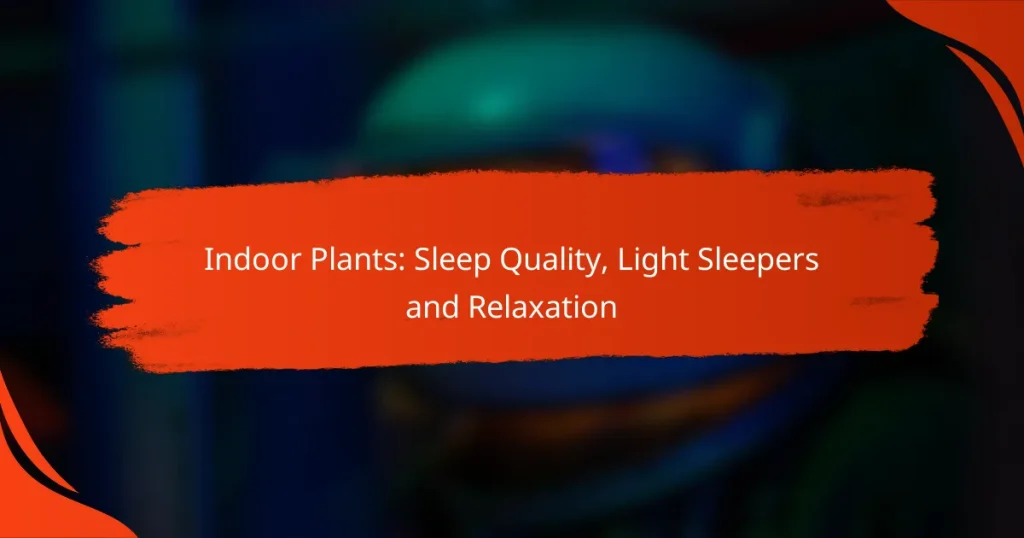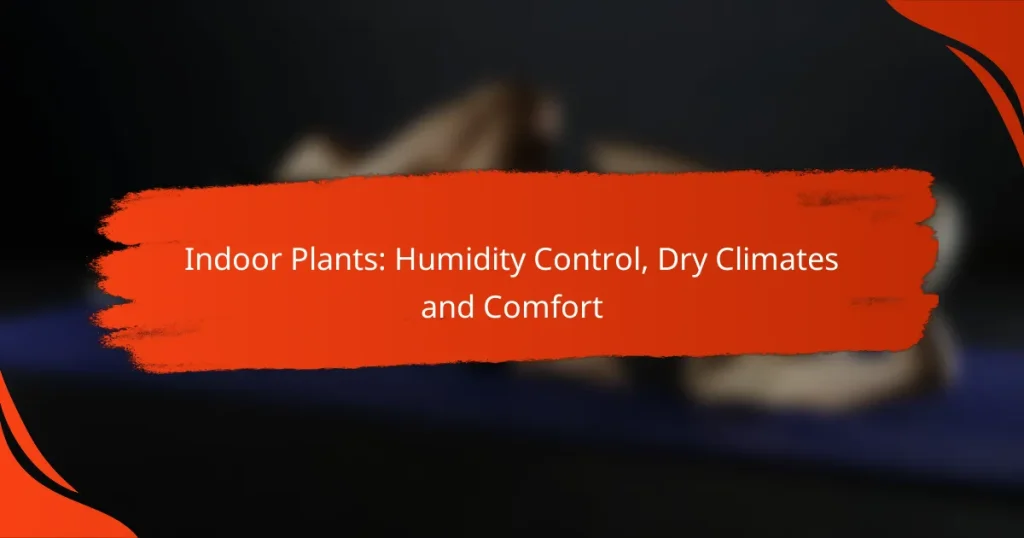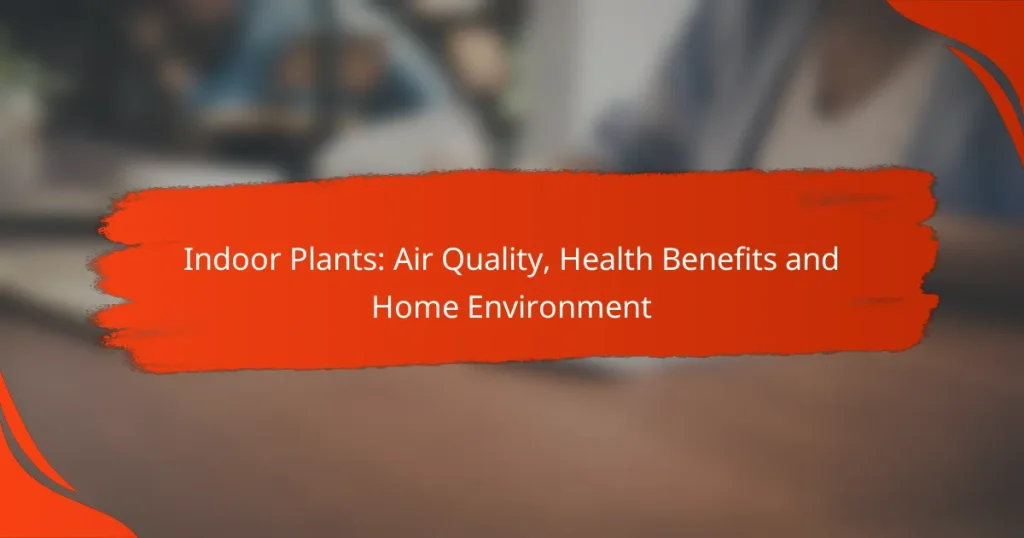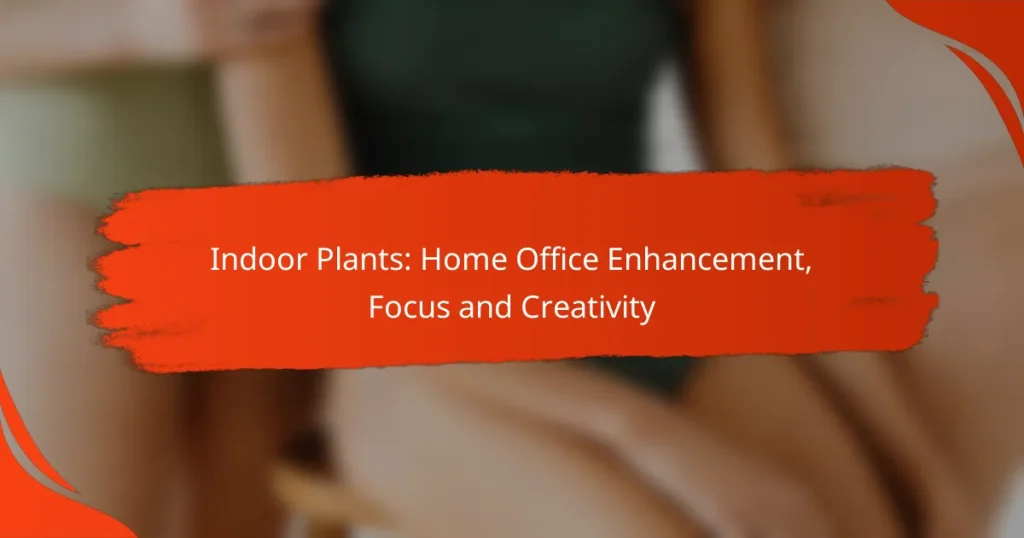Indoor plants are not just decorative elements; they play a vital role in improving air quality by filtering pollutants and increasing oxygen levels. Additionally, they contribute to mental well-being by reducing stress and enhancing mood, making your home a more inviting and calming space. With their ability to beautify any environment, indoor plants can transform your living area into a vibrant sanctuary.
Indoor Plants: Humidity Control, Dry Climates and Comfort
Indoor Plants: Air Quality, Health Benefits and Home Environment
Indoor Plants: Home Office Enhancement, Focus and Creativity
How do indoor plants improve air quality?
Indoor plants enhance air quality by filtering out harmful pollutants and increasing oxygen levels. They absorb carbon dioxide and release oxygen through photosynthesis, creating a healthier living environment.
Reduction of indoor pollutants
Indoor plants can effectively reduce common indoor pollutants such as formaldehyde, benzene, and trichloroethylene. These substances are often found in household items like cleaning products, furniture, and carpets. By incorporating plants like spider plants or peace lilies, you can significantly lower the concentration of these harmful compounds in your home.
Research indicates that certain plants can remove up to 80% of indoor toxins within a few hours. Regularly maintaining your plants ensures they remain effective air purifiers.
Increased oxygen levels
Plants contribute to higher oxygen levels in indoor spaces through the process of photosynthesis. During daylight hours, they absorb carbon dioxide and release oxygen, which can improve overall air quality. For optimal oxygen production, consider placing multiple plants in well-lit areas of your home.
Popular oxygen-producing plants include snake plants and pothos, which are both easy to care for and thrive in various lighting conditions.
Humidity regulation
Indoor plants help regulate humidity levels by releasing moisture into the air through a process called transpiration. This can be particularly beneficial in dry environments or during winter months when heating systems lower indoor humidity. Maintaining a humidity level of around 30-50% can enhance comfort and reduce respiratory issues.
To maximize humidity benefits, group plants together or use a humidifier alongside them. Plants like ferns and rubber trees are particularly effective at increasing humidity levels in your home.
What are the mental health benefits of indoor plants?
Indoor plants offer significant mental health benefits, including stress reduction, enhanced mood, and improved focus. By incorporating greenery into your living space, you can create a calming environment that promotes overall well-being.
Stress reduction
Indoor plants can effectively reduce stress levels by providing a sense of tranquility and connection to nature. Studies suggest that simply being around plants can lower cortisol levels, the hormone associated with stress. Consider placing plants in areas where you spend the most time, such as your living room or home office.
To maximize stress relief, choose plants known for their calming effects, such as peace lilies or snake plants. Regularly caring for your plants can also serve as a mindful activity, further alleviating stress.
Enhanced mood
Having indoor plants can significantly enhance your mood by creating a more inviting and pleasant atmosphere. The presence of greenery can trigger positive emotions and reduce feelings of anxiety and depression. A simple addition of a few houseplants can transform a dull space into a vibrant one.
To boost your mood, select plants with bright foliage or flowers, like gerbera daisies or pothos. Position them in well-lit areas to maximize their visual impact and uplifting effects.
Improved focus and productivity
Indoor plants can improve focus and productivity by enhancing air quality and creating a more stimulating environment. Research indicates that having plants in workspaces can lead to increased concentration and creativity. Incorporating plants into your home office can help maintain your energy levels throughout the day.
For optimal results, consider plants that require minimal maintenance, such as succulents or ZZ plants. These options allow you to enjoy the benefits without the burden of extensive care, ensuring your focus remains on your tasks.
How do indoor plants enhance home aesthetics?
Indoor plants significantly enhance home aesthetics by adding natural beauty and vibrancy to living spaces. They create a calming atmosphere and can serve as focal points or subtle accents, depending on their placement and variety.
Variety of colors and textures
Indoor plants come in a wide range of colors and textures, which can complement any decor. From the deep greens of ferns to the vibrant hues of flowering plants, the diversity allows homeowners to choose options that match their personal style.
Incorporating plants with different leaf shapes and sizes can add visual interest. For example, a spiky snake plant can contrast beautifully with the round leaves of a pothos, creating a dynamic display.
Complementary to interior design styles
Indoor plants can seamlessly fit into various interior design styles, enhancing the overall aesthetic. For instance, minimalist spaces benefit from sleek, simple plants like succulents, while bohemian designs can be enriched with lush, trailing vines.
When selecting plants, consider the existing color palette and furniture. A well-placed plant can tie together different elements of a room, making it feel more cohesive and inviting.
What are the best indoor plants for beginners?
The best indoor plants for beginners are those that are easy to care for and resilient. Snake plants, pothos, and spider plants are popular choices due to their low maintenance requirements and adaptability to various indoor conditions.
Snake plant
Snake plants, also known as Sansevieria, are ideal for beginners because they thrive in low light and require minimal watering. They can tolerate neglect, making them perfect for busy lifestyles.
When caring for snake plants, ensure the soil drains well to prevent root rot. Water them every few weeks, allowing the soil to dry out completely between waterings.
Pothos
Pothos, or Epipremnum aureum, is another excellent choice for novice plant owners. This trailing vine can grow in a variety of lighting conditions, from low light to bright, indirect sunlight.
To care for pothos, water when the top inch of soil feels dry. They are forgiving plants, so if you forget to water occasionally, they will bounce back quickly.
Spider plant
Spider plants, or Chlorophytum comosum, are known for their air-purifying qualities and attractive arching leaves. They are resilient and can thrive in a range of indoor environments.
For optimal growth, place spider plants in bright, indirect light and water them when the soil is dry to the touch. They also produce “baby” plants that can be easily propagated, making them a fun project for beginners.
How do I care for indoor plants?
Caring for indoor plants involves understanding their specific needs for water, light, and soil. Proper attention to these factors ensures healthy growth and longevity of your plants.
Watering guidelines
Watering is crucial for indoor plants, but the frequency varies by species. Generally, it’s best to check the top inch of soil; if it’s dry, it’s time to water. Overwatering is a common mistake, so ensure pots have drainage holes to prevent root rot.
As a rule of thumb, many indoor plants thrive with watering once a week, but this can change with seasons and humidity levels. During warmer months, you may need to increase watering, while in cooler months, reduce it.
Light requirements
Indoor plants have varying light needs, from low to bright indirect light. Assess the light conditions in your home and choose plants that match those conditions to promote healthy growth.
For example, succulents and cacti prefer bright light, while ferns and snake plants can tolerate lower light levels. Rotate your plants occasionally to ensure even light exposure on all sides.
Soil and potting tips
Choosing the right soil is essential for indoor plants, as it affects drainage and nutrient availability. A general potting mix works for many plants, but some may require specialized soil, such as cactus mix for succulents.
When potting, select a container that allows for proper drainage and is slightly larger than the root ball. Repotting every couple of years can refresh the soil and provide more space for growth.
What factors should I consider when choosing indoor plants?
When selecting indoor plants, consider factors such as the available space, light conditions, maintenance requirements, and safety for pets and allergy sufferers. These elements will help ensure that your chosen plants thrive and enhance your living environment.
Space and light availability
Assessing your space and light availability is crucial when choosing indoor plants. Different plants have varying light requirements; some thrive in bright, direct sunlight while others prefer low-light conditions. For example, succulents and cacti need ample sunlight, while snake plants and pothos can tolerate shadier spots.
Measure the amount of natural light your space receives throughout the day. A simple rule of thumb is to place plants that need more light near windows and those that require less light further away. Consider the size of the plants as well; larger plants need more space to grow without overcrowding.
Maintenance level
Maintenance level is another important factor when selecting indoor plants. Some plants require frequent watering, pruning, and repotting, while others are more forgiving and can thrive with minimal care. For instance, peace lilies need regular watering and occasional fertilization, whereas ZZ plants can survive on infrequent watering.
Evaluate your lifestyle and the time you can dedicate to plant care. If you travel often or have a busy schedule, opt for low-maintenance varieties like succulents or snake plants that can tolerate neglect. Make a checklist of your availability for watering, cleaning, and repotting to guide your choices.
Allergies and pet safety
When choosing indoor plants, consider allergies and pet safety. Some plants can trigger allergic reactions in sensitive individuals, while others may be toxic to pets. For example, common houseplants like spider plants and Boston ferns are generally safe for pets, whereas lilies and philodendrons can be harmful.
Research the plants you are considering to ensure they are non-toxic and hypoallergenic. If you have pets, look for resources that list safe plants, and keep potentially harmful varieties out of reach. Always monitor your pets around new plants to ensure they do not exhibit any adverse reactions.
What are the unique benefits of specific indoor plants?
Specific indoor plants offer a variety of unique benefits that can enhance your home environment. These advantages include improved air quality, increased humidity, and even psychological benefits such as reduced stress and enhanced mood.
Air purification
Certain indoor plants are known for their ability to purify the air by removing toxins and pollutants. For example, plants like the spider plant, peace lily, and snake plant can absorb harmful substances such as formaldehyde and benzene, making your indoor air cleaner and healthier.
To maximize air purification, consider placing one plant per 100 square feet of space. This can help ensure that the plants effectively contribute to improving air quality throughout your home.
Humidity regulation
Indoor plants can naturally increase humidity levels in your home, which is beneficial for respiratory health and skin hydration. Plants such as the Boston fern and rubber plant release moisture into the air through a process called transpiration.
Maintaining a humidity level between 30% and 50% is ideal for comfort and health. Placing several humidity-loving plants in dry areas can help achieve this balance, especially during winter months when indoor air tends to be drier.
Stress reduction
Having indoor plants can significantly reduce stress and promote a sense of well-being. Studies have shown that interacting with plants can lower cortisol levels, leading to a calmer environment. Plants like lavender and jasmine are particularly known for their soothing scents.
To create a stress-reducing atmosphere, consider incorporating plants into your workspace or relaxation areas. A few strategically placed plants can enhance your mood and create a more inviting space.



